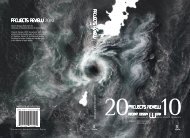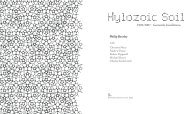The Inner Studio - Riverside Architectural Press
The Inner Studio - Riverside Architectural Press
The Inner Studio - Riverside Architectural Press
Create successful ePaper yourself
Turn your PDF publications into a flip-book with our unique Google optimized e-Paper software.
THE INNER STUDIO<br />
living in Philadelphia, I looked up the number of George<br />
Nakashima, and the woman who answered the phone told me the<br />
studio was closed because he had recently passed away. I put the<br />
phone down and waited.<br />
It Takes Time<br />
A year later I called again and learned that the studio had reopened.<br />
I can remember my first thought when I rubbed my hand across the<br />
furniture: George Nakashima had a different attitude to work than<br />
most people. He loved what he did. It was obvious that every piece<br />
in the studio was a work of love, every piece was mindfully created<br />
before it was made. I felt myself slow down in the presence of this<br />
lesson. Patience and reflection were woven so deeply into the objects<br />
that creation showed no sign of time. I became more reflective. Time<br />
was not the factor driving these creations. Whoever had the time to<br />
make these works had recognized and made a great connection with<br />
the timeless. Looking at a table, I felt his discipline and the seldomtasted<br />
freedom that comes from such patience. What happens to the<br />
purpose of production when time is withdrawn as the great shaper<br />
of things? If not time, then who and what will determine the start<br />
and end of things? What could replace the clock? I felt my own<br />
sense of time expand and dissolve as I looked at the work. <strong>The</strong>se<br />
pieces weren’t so much about willing an outcome as they were a tacit<br />
consent to serve and honor the spiritual part of us that creates. This<br />
furniture was a built meditation on the absolute sum of the inner<br />
and the outer world. Issues of function seemed unimportant. <strong>The</strong><br />
energy and poise of each piece felt like an offering and my own sense<br />
of the sacred was illuminated in their presence.<br />
Perhaps some things were meant to be built in response to<br />
unseen forces, out of time, out of the eye of society and into the lost<br />
world of physical things. Why can’t the built world call us like a<br />
shaman’s drum? This isn’t the way we do things now. <strong>The</strong> Jungian<br />
analyst James Hollis says the test for soul is found in three things:<br />
luminosity, depth, and resonance. I want to add another quality<br />
that I found in this studio: the voices of ancestors. <strong>The</strong> voices of the<br />
ones who have come before were strong.<br />
68





